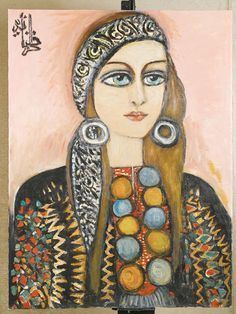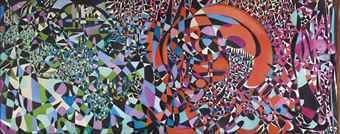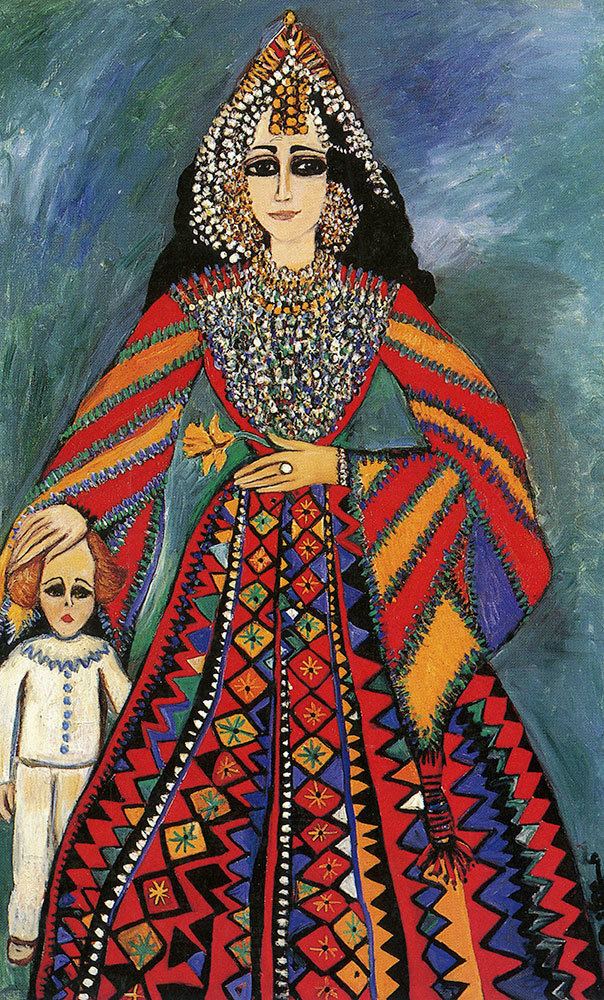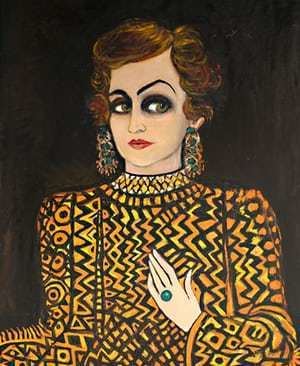Name Princess Zeid Role Artist | Children Ra'ad bin Zeid Siblings Cevat Sakir Kabaagacli | |
 | ||
Artwork Untitled, Divine Protection, Paris, My Hell, Emir Zeid Similar People Aliye Berger, Mehmet Sakir Pasa, Ra'ad bin Zeid, Cevat Sakir Kabaagacli, Prince Zeid bin Ra'ad | ||
Princess Fahrelnissa Zeid Google Doodle
Fahrelnissa Zeid (Arabic: الأميرة فخر النساء زيد) or Fahr-El-Nissa (7 January 1901 – 5 September 1991) was a Turkish artist best known for her large-scale abstract paintings. Although predominantly a painter, she also made drawings, lithographs, and sculptures. Her work blended elements of Islamic and Byzantine art with abstraction and other influences from the West.
Contents
- Princess Fahrelnissa Zeid Google Doodle
- Princess Fahrelnissa Zeid Fahrelnissa Zeidin 118 Ya Gn Google Doodle
- Early life
- 19301944
- 19451957
- 19581991
- Major works
- References

She married into the Hashemite royal family of Iraq. She was the mother of Prince Ra'ad bin Zeid and the grandmother of Prince Zeid bin Ra'ad.

Princess Fahrelnissa Zeid - Fahrelnissa Zeid’in 118. Yaş Günü (Google Doodle)
Early life

Fahrelnissa Zeid was born Fahrünissa Şakir (hereafter referred to as Zeid), into an elite Ottoman family on the island of Büyükada. Her uncle, Cevat Pasha served as the Grand vizier of the Ottoman Empire from 1891 to 1895. Zeid’s father Şakir Pasha was appointed ambassador to Greece, where he met Zeid’s mother Sara İsmet Hanım. In 1913, Zeid’s father was fatally shot and her brother, also named Cevat, was tried and convicted of his murder.

Zeid began drawing and painting at a young age. Her earliest known surviving work is a portrait of her grandmother, painted when she was 14. In 1919, Zeid enrolled at the Academy of Fine Arts for Women, in Istanbul.
In 1920 at the age of nineteen, Zeid married the novelist İzzet Melih Devrim. For their honeymoon, Devrim took Zeid to Venice where she was exposed to European painting traditions for the first time. They had three children together. Her eldest son, Faruk (born 1921), died of scarlet fever in 1924. Her son Nejad (born 1923) went on to become a painter, and her daughter Şirin Devrim (born 1926) became an actress.

Zeid travelled to Paris in 1928 and enrolled at the Académie Ranson, where she studied under the painter Roger Bissière. Upon her return to Istanbul in 1929, Zeid enrolled at the Istanbul Academy of Fine Arts.
1930–1944
Zeid divorced Devrim in 1934, and married Prince Zeid Al-Hussein of Iraq, who was appointed the first Ambassador of the Kingdom of Iraq to Germany in 1935. The couple moved to Berlin where Zeid hosted many social events in her role as an ambassador’s wife. After the annexation of Austria in March 1938, Prince Zeid and his family were recalled to Iraq, taking up residence in Baghdad.

Zeid became depressed in Baghdad and on the advice of a Viennese doctor returned to Paris after a short time. She spent the next years of her life traveling between Paris, Budapest, and Istanbul, attempting to immerse herself in painting and recover. By 1941, she was back in Istanbul and focusing on her painting.
Zeid became involved with the d Group of Istanbul, an avant-garde group of painters working in the newly formed Turkish Republic under Mustafa Kemal Atatürk. Although her association with the group was short-lived, exhibiting with the d Group from 1944 gave Zeid the confidence to begin exhibiting on her own.
1945–1957
In 1945, Zeid cleared out the parlor rooms of her apartment in Istanbul and held her first solo exhibition. In 1946, after two more solo exhibitions at İzmir in 1945 and in Istanbul in 1946, Zeid relocated to London where Prince Zeid Al-Hussein became the first Ambassador of the Kingdom of Iraq to the Court of St James's. Zeid continued to paint, turning a room in the Iraqi Embassy into her studio.
From 1947, Zeid’s practice became more complex and her work transitioned from figurative painting to abstraction. Zeid was influenced by the abstract styles coming out of Paris in the post-war period. She uniquely fused her Persian, Byzantine, Cretan, and Oriental roots with concepts, styles and techniques of Modernism in her painterly practice.
She exhibited in London at Saint George’s Gallery in 1948. Queen Elizabeth The Queen Mother attended the opening. Due to her position in the Iraqi Royal Family, many high society members attended her openings and exhibitions. Art critic Maurice Collis reviewed her 1948 exhibition and they subsequently became friends. The prominent French art critic and curator Charles Estienne became a major proponent of Zeid’s work.
Over the next decade, living between London and Paris, Zeid made some of her strongest works, experimenting with monumental abstract canvases that immerse the viewer in kaleidoscopic universes through their heavy use of line and vibrant colour. Zeid exhibited at Galerie Dina Vierny in 1953, showing her most recent abstract works such as The Octopus of Triton, and Sargasso Sea. The exhibition travelled to the Institute of Contemporary Arts in London in 1954. In the mid-1950s Zeid was at the height of her career.
1958–1991
In 1958, Zeid convinced her husband Prince Zeid al-Hussein not to return to Baghdad as acting regent while his great nephew, King Faisal II, went on vacation as he usually did. The couple went to their holiday home on the island of Ischia in the Gulf of Naples. On 14 July 1958 there was a military coup in Iraq and the entire royal family was assassinated. Prince Zeid and his family narrowly escaped death, and they were given only 24-hours to vacate the Iraqi Embassy in London. The coup halted Zeid’s career as a painter and hostess in London.
Zeid and her family moved into an apartment in London and at the age of fifty-seven, Zeid cooked her first meal. The experience prompted her to begin painting on chicken bones, later creating sculptures from the bones cast in resin, called paléokrystalos. In her painting, she began to move away from abstraction, and started to paint portraits of her family and others close to her.
A few years later, her youngest son, Prince Raad, married and moved to Amman, Jordan. In 1970, Prince Zeid Al-Hussein died in Paris and Zeid moved to join her son in Amman in 1975. She founded The Royal National Jordanian Institute Fahrelnissa Zeid of Fine Arts in 1976, and for the next fifteen years she taught and mentored a group of young women until her death in 1991.
Museum Ludwig held her first retrospective in the western world in 1990. In October 2012, a number of her paintings were sold at auction by Bonhams for a total of £2,021,838. The authorized biography Fahrelnissa Zeid: Painter of Inner Worlds, written by Adila Laïdi-Hanieh, a former student of Zeid's, was published in 2017 by London publishers Art / Books to coincide with a major retrospective exhibition at Tate Modern.
